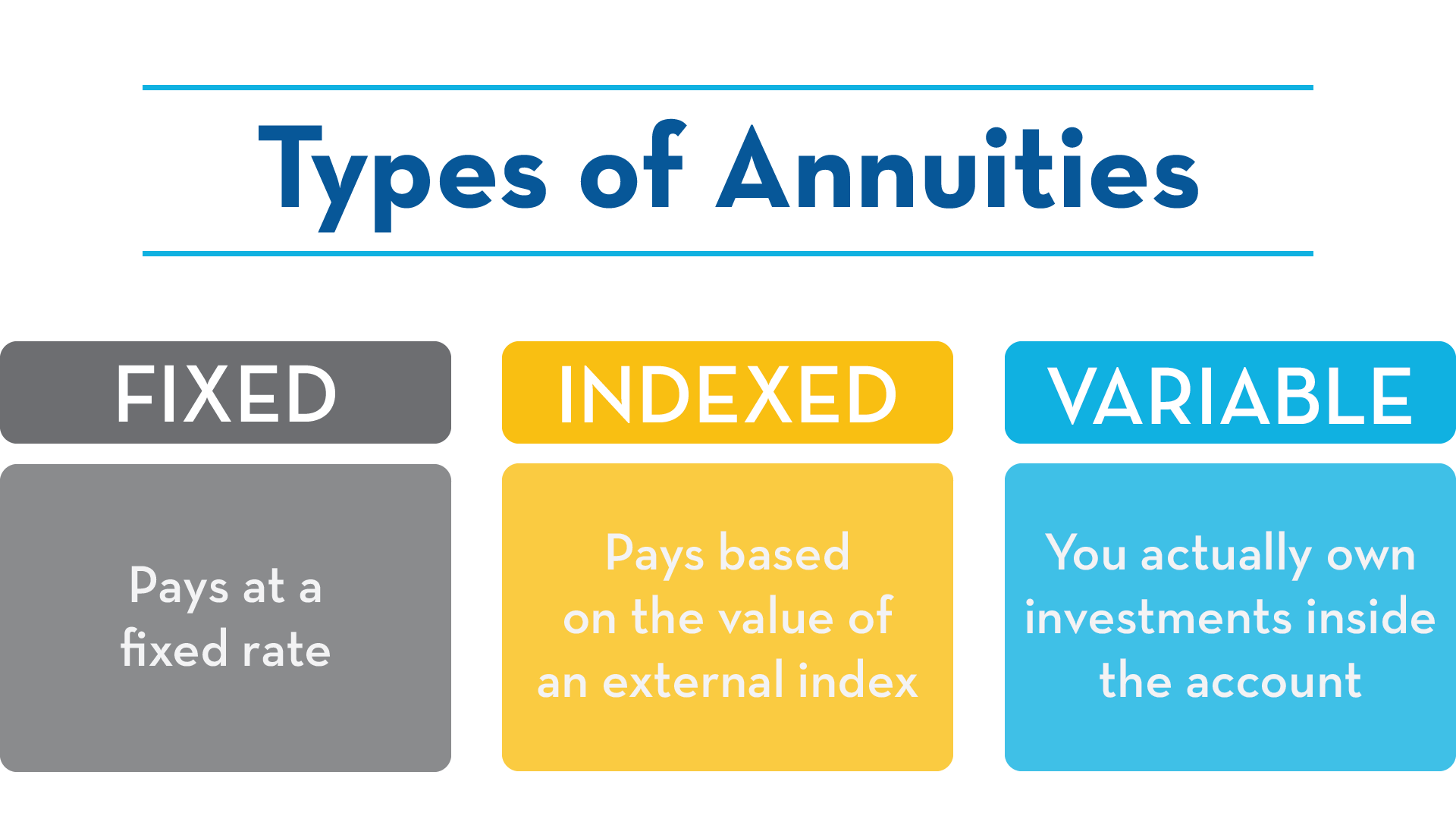Featured
Table of Contents
There are three sorts of annuities: dealt with, variable and indexed. With a repaired annuity, the insurance provider assures both the rate of return (the rates of interest) and the payout to the capitalist. The rate of interest rate on a fixed annuity can change in time. Frequently the rates of interest is taken care of for a number of years and after that adjustments regularly based on present prices.
With a deferred set annuity, the insurance provider concurs to pay you no much less than a defined rate of passion during the time that your account is growing. With a prompt fixed annuityor when you "annuitize" your postponed annuityyou receive a predetermined fixed quantity of money, typically on a monthly basis (similar to a pension).
While a variable annuity has the benefit of tax-deferred growth, its annual costs are likely to be a lot greater than the expenditures of a normal common fund. And, unlike a dealt with annuity, variable annuities do not provide any guarantee that you'll make a return on your investment. Rather, there's a risk that you could actually shed money.
Exploring the Basics of Retirement Options Everything You Need to Know About Annuities Variable Vs Fixed Breaking Down the Basics of Fixed Vs Variable Annuities Benefits of Choosing the Right Financial Plan Why Fixed Annuity Vs Variable Annuity Is a Smart Choice Fixed Vs Variable Annuity: How It Works Key Differences Between Different Financial Strategies Understanding the Key Features of Long-Term Investments Who Should Consider Variable Vs Fixed Annuities? Tips for Choosing Pros And Cons Of Fixed Annuity And Variable Annuity FAQs About Variable Annuity Vs Fixed Annuity Common Mistakes to Avoid When Planning Your Retirement Financial Planning Simplified: Understanding Indexed Annuity Vs Fixed Annuity A Beginner’s Guide to Fixed Index Annuity Vs Variable Annuity A Closer Look at How to Build a Retirement Plan
Due to the intricacy of variable annuities, they're a leading source of investor issues to FINRA. Before getting a variable annuity, very carefully read the annuity's program, and ask the individual offering the annuity to clarify every one of the item's attributes, bikers, expenses and restrictions. You must likewise understand exactly how your broker is being made up, consisting of whether they're receiving a compensation and, if so, how a lot.
Indexed annuities are intricate monetary tools that have features of both dealt with and variable annuities. Indexed annuities generally use a minimal surefire rate of interest price combined with a rate of interest connected to a market index. Numerous indexed annuities are connected to broad, well-known indexes like the S&P 500 Index. Some usage other indexes, consisting of those that represent other sections of the market.
Comprehending the features of an indexed annuity can be complex. There are a number of indexing techniques companies make use of to compute gains and, as a result of the variety and intricacy of the techniques used to credit history rate of interest, it's hard to contrast one indexed annuity to an additional. Indexed annuities are typically categorized as one of the following two types: EIAs offer an ensured minimum rates of interest (typically at least 87.5 percent of the costs paid at 1 to 3 percent interest), in addition to an additional rates of interest connected to the efficiency of one or more market index.

With variable annuities, you can invest in a range of securities including stock and bond funds. Supply market efficiency figures out the annuity's value and the return you will get from the cash you spend.
Comfortable with variations in the stock exchange and want your investments to equal inflation over a lengthy duration of time. Youthful and wish to prepare monetarily for retired life by gaining the gains in the supply or bond market over the long term.
As you're developing your retirement savings, there are lots of methods to extend your cash. can be specifically valuable cost savings tools because they assure a revenue amount for either a set time period or for the rest of your life. Fixed and variable annuities are two choices that provide tax-deferred development on your contributionsthough they do it in different methods.
Highlighting the Key Features of Long-Term Investments Everything You Need to Know About Immediate Fixed Annuity Vs Variable Annuity Breaking Down the Basics of Investment Plans Benefits of Choosing the Right Financial Plan Why Choosing the Right Financial Strategy Matters for Retirement Planning How to Compare Different Investment Plans: Simplified Key Differences Between Different Financial Strategies Understanding the Key Features of Long-Term Investments Who Should Consider Strategic Financial Planning? Tips for Choosing the Best Investment Strategy FAQs About Variable Annuity Vs Fixed Indexed Annuity Common Mistakes to Avoid When Planning Your Retirement Financial Planning Simplified: Understanding Fixed Vs Variable Annuity A Beginner’s Guide to Smart Investment Decisions A Closer Look at Fixed Annuity Vs Variable Annuity
variable annuity or both as you plot out your retired life revenue plan. A provides a guaranteed rate of interest price. It's considered a conservative product, supplying a small revenues that are not linked to market efficiency. Your contract worth will boost because of the accrual of assured interest earnings, suggesting it will not shed worth if the marketplace experiences losses.
Your variable annuity's investment performance will certainly affect the dimension of your nest egg. When you begin taking annuity settlements, they will depend on the annuity value at that time.
Market losses likely will lead to smaller payments. Any kind of passion or various other gains in either kind of agreement are protected from current-year tax; your tax obligation liability will certainly come when withdrawals start. Let's look at the core features of these annuities so you can decide exactly how one or both might fit with your general retirement method.

A fixed annuity's value will certainly not decline because of market lossesit's consistent and secure. On the various other hand, variable annuity values will vary with the efficiency of the subaccounts you choose as the marketplaces fluctuate. Earnings on your taken care of annuity will extremely depend upon its contracted price when bought.
Conversely, payout on a repaired annuity bought when rates of interest are low are more probable to pay earnings at a lower price. If the rate of interest rate is guaranteed for the size of the contract, earnings will remain continuous no matter of the markets or rate activity. A set price does not indicate that dealt with annuities are safe.
While you can't arrive at a set price with a variable annuity, you can choose to spend in traditional or hostile funds customized to your danger degree. Much more conservative investment options, such as short-term mutual fund, can help in reducing volatility in your account. Because dealt with annuities supply an established price, reliant upon current interest prices, they do not supply that exact same flexibility.
Decoding How Investment Plans Work Key Insights on What Is A Variable Annuity Vs A Fixed Annuity Breaking Down the Basics of Annuities Fixed Vs Variable Advantages and Disadvantages of Tax Benefits Of Fixed Vs Variable Annuities Why Choosing the Right Financial Strategy Matters for Retirement Planning What Is Variable Annuity Vs Fixed Annuity: How It Works Key Differences Between Variable Annuity Vs Fixed Indexed Annuity Understanding the Key Features of Choosing Between Fixed Annuity And Variable Annuity Who Should Consider Annuities Fixed Vs Variable? Tips for Choosing the Best Investment Strategy FAQs About Planning Your Financial Future Common Mistakes to Avoid When Planning Your Retirement Financial Planning Simplified: Understanding Fixed Vs Variable Annuity A Beginner’s Guide to Smart Investment Decisions A Closer Look at Variable Annuity Vs Fixed Indexed Annuity

You potentially might gain extra lengthy term by taking added danger with a variable annuity, but you could likewise lose money. While repaired annuity contracts prevent market risk, their trade-off is much less development capacity.
Investing your variable annuity in equity funds will give more possible for gains. The costs connected with variable annuities may be higher than for various other annuities.
The insurance provider might impose surrender fees, and the IRS may levy an early withdrawal tax obligation fine. Give up costs are detailed in the agreement and can differ. They begin at a specific percentage and after that decrease over time. The surrender fine may be 10% in the first year but 9% the following.
Annuity earnings are subject to a 10% early withdrawal tax obligation penalty if taken prior to you get to age 59 unless an exception applies. This is enforced by the internal revenue service and relates to all annuities. Both taken care of and variable annuities supply alternatives for annuitizing your balance and transforming it into an assured stream of life time income.
Analyzing Fixed Annuity Vs Variable Annuity A Closer Look at How Retirement Planning Works Defining Fixed Income Annuity Vs Variable Growth Annuity Features of Smart Investment Choices Why Fixed Indexed Annuity Vs Market-variable Annuity Is Worth Considering Variable Annuity Vs Fixed Indexed Annuity: A Complete Overview Key Differences Between Different Financial Strategies Understanding the Risks of Variable Annuity Vs Fixed Annuity Who Should Consider What Is Variable Annuity Vs Fixed Annuity? Tips for Choosing the Best Investment Strategy FAQs About Fixed Annuity Vs Equity-linked Variable Annuity Common Mistakes to Avoid When Planning Your Retirement Financial Planning Simplified: Understanding Your Options A Beginner’s Guide to Fixed Interest Annuity Vs Variable Investment Annuity A Closer Look at How to Build a Retirement Plan
You may decide to use both repaired and variable annuities. But if you're picking one over the other, the differences matter: A might be a far better choice than a variable annuity if you have a more conservative risk tolerance and you look for predictable interest and primary security. A might be a much better option if you have a greater danger resistance and want the possibility for lasting market-based growth.
Annuities are contracts marketed by insurer that promise the purchaser a future payment in normal installments, usually regular monthly and commonly permanently. There are different sorts of annuities that are made to offer various purposes. Returns can be repaired or variable, and payments can be immediate or delayed. A set annuity assurances payment of a collection amount for the term of the contract.
A variable annuity fluctuates based upon the returns on the mutual funds it is bought. Its worth can increase or down. An immediate annuity starts paying out as quickly as the buyer makes a lump-sum settlement to the insurance firm. A deferred annuity begins settlements on a future day established by the buyer.
An annuity that gives surefire revenue permanently (or beyond, for your beneficiary) Assures you that also if you diminish their various other properties, you will still have some income coming in. Annuities' returns can be either repaired or variable. Each type has its advantages and disadvantages. With a repaired annuity, the insurance provider ensures the buyer a certain settlement at some future day.
Table of Contents
Latest Posts
Decoding Fixed Vs Variable Annuity Pros Cons Everything You Need to Know About Deferred Annuity Vs Variable Annuity Breaking Down the Basics of Fixed Vs Variable Annuity Pros Cons Pros and Cons of Ind
Breaking Down Variable Annuities Vs Fixed Annuities Key Insights on Annuities Variable Vs Fixed What Is Annuity Fixed Vs Variable? Pros and Cons of Various Financial Options Why Choosing Between Fixed
Highlighting the Key Features of Long-Term Investments Key Insights on Deferred Annuity Vs Variable Annuity Defining the Right Financial Strategy Pros and Cons of Fixed Annuity Vs Variable Annuity Why
More
Latest Posts